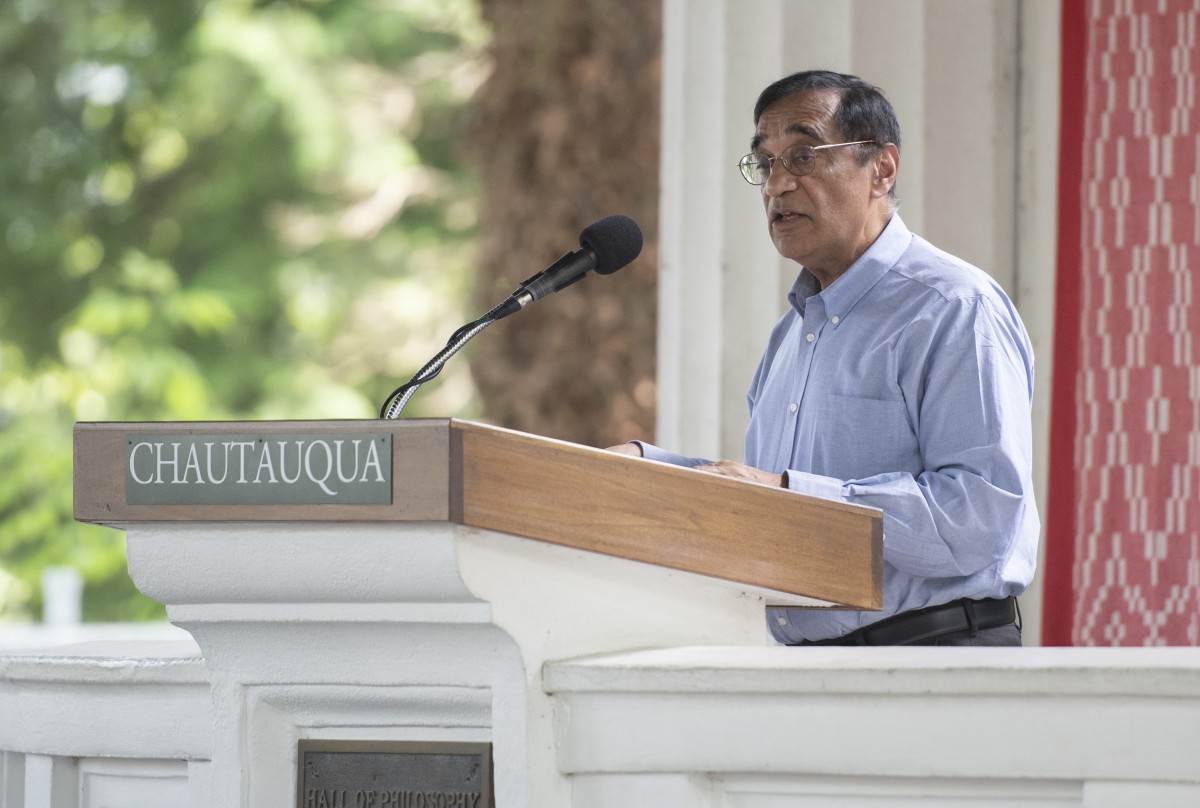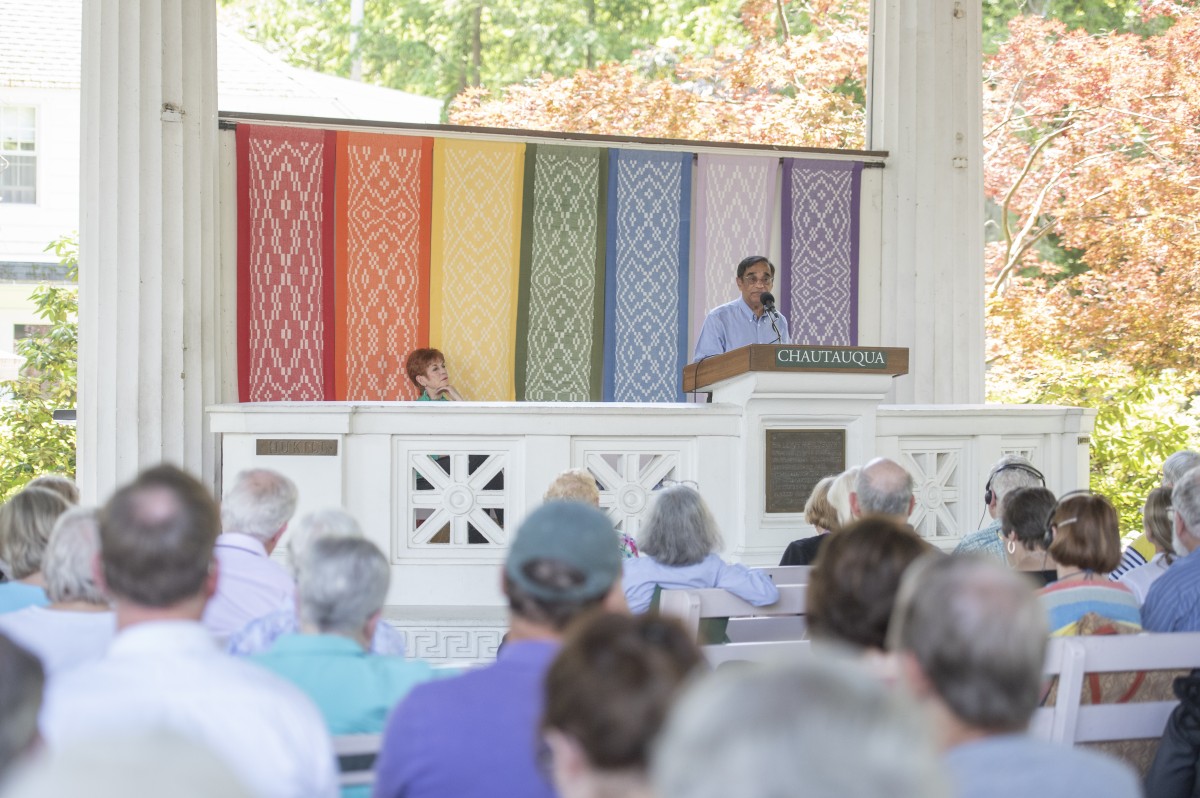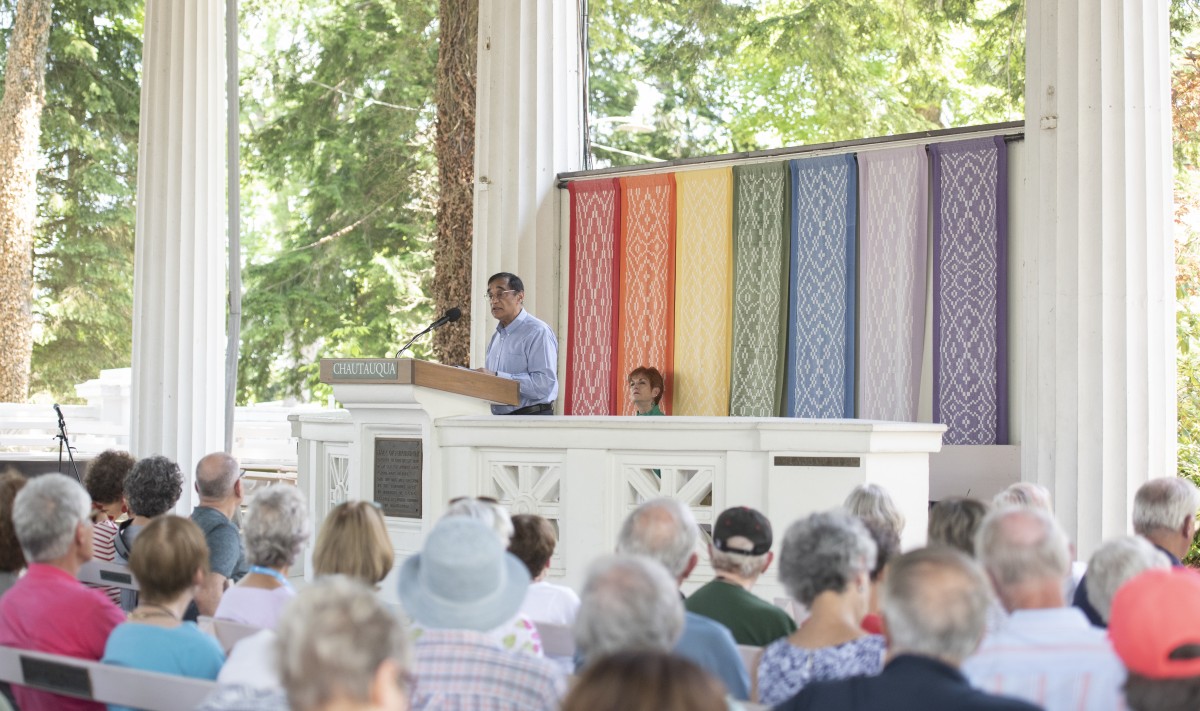According to Wilfred Cantwell Smith, a renowned historian of religion, the “contemporary notions of religion are so radically different from those held by the personalities we identify as the founders of the world’s major religions, such as the Buddha, Moses, Jesus and Muhammad, that they would not be able to recognize the religions the world associates them with today.”
In his lecture Thursday in the Hall of Philosophy, “Encountering the Divine as Beauty: Rethinking Islamic Origins,” Ali Asani, professor of Indo-Muslim and Islamic religion and cultures at Harvard University, explored the beginning of Islam and traced its evolution to the two interpretations and identities that currently exist, islam and Islam.
Asani studied under Smith while at Harvard. Smith said that as a consequence of such change and evolution of religion over time, every new generation influences religion in a new way.
“Since every religion is necessarily located within the context of human history, it is part of the mundane, but constantly changing and evolving world of humanity,” Smith said. “As a result, it is unstable, dynamic and strongly influenced by the milieu in which it is situated.”
With this constant change that occurs within religions, Asani felt it best to go back to one of the earliest and key moments in the history of Islam, particularly the revelation of the Quran, a text Muslims consider to be the word of God revealed to the Prophet Muhammad, in 610 C.E.
Asani began by revealing one of the greatest paradoxes of history: Muhammad never intended the Quran to be a written work or the foundation of “a systemized religion.” In fact, during Muhammad’s lifetime, the Quran was an aural and oral text, meant to be memorized and recited out loud for all to hear.
“With its rhyme schemes and sound patterns, it bears all the hallmarks of a text meant to be publicly performed and privately experienced,” Asani said.
Muhammad was known to retreat to a cave, called Hira, located on the mountain Jabal an-Nour near Mecca. There, he would meditate. One day, amid his meditation, he heard a loud voice demanding him to recite. Muhammad, struck with fear by the voice, reluctantly rejected the demand, saying he was unable to recite.
“The voice became more insistent,” Asani said. “Finally, (Muhammad) felt himself being held in such a tight embrace that he could hardly breathe, and the voice proclaimed what became the first revelation and the recitation: ‘Recite in the name of the Lord who created human kind from a clot.’ ”
“The Quran is a text that Muslims considered to be the word of God revealed to the prophet of Muhammad…however, it is one of the great paradoxes in history that Muhammad didn’t intend for it to be written…” #CHQ2019
— The Chautauquan Daily (@chqdaily) June 27, 2019
The experience was bewildering to Muhammad, and he ran down the mountain shaking violently. He rushed home, and once he arrived, he hid in his bed under a blanket. His wife became worried and contacted her cousin, a member of a Jewish-Christian community called the Ebionites. He thought that Muhammad was possibly a prophet. After this day, Muhammad went on to receive several more revelations over the course of 23 years.
“As he would recite them, people flocked to hear him,” Asani said. “As they had never heard anything more beautiful in the Arabic language, … they would weep openly and uncontrollably, just moved by its beauty.”
Muhammad’s popularity soon grew, and along with his listeners also came enemies. Some accused him of being a magician or sorcerer. Even his enemies, though, could not deny the beauty of Muhammad’s word, and would immediately become his followers after listening to him recite.
Asani then quoted a Quranic text: “God has sent down the most beautiful of all teachings, a scripture that is consistent and draws comparison, that causes the skin of those in awe of God to shiver,” something like goosebumps,“Asani added. Then their skins and their hearts soften at the mention of God.”
Despite the beauty of the text, accusations persisted against Muhammad. Some suspected Muhammad of being a poet. Poets at that time were believed to be able to bewitch people with their writings because they were assisted in their writing by spirits or jinns. Jinns are spirits from Arabic mythology comparable to genies.
Muhammad, in response to the accusations, declared he was a prophet, not a poet, and that what he was reciting came not from a jinn, but from God. Skeptics pressed Muhammad for proof of such a claim. In response, the prophet challenged them to produce a work of equal or better magnificence.
Asani then quoted the Quran, “If mankind and the jinn gathered in order to produce the like of this Quran, they could not produce its light, even if they were to back one another.”
The proof of the recitation’s divine origin was evident in light of the fact that it was inimitable.
The Quran’s word was like no other. It struck people with its beauty, gripped people with its stories and delighted those who were in need of warmth. Asani said the Quran, in the time of Muhammad, was so impactful that “the listener found himself immersed in light,” causing his heart and mind to glow.
As the Iranian scholar Muhammad Taqi Shariati-Mazinani described it: “The Quran was a light that shone through the aperture of the ear; it transformed the soul and, as a result, the world.”
“And embedded in its text was an invitation to its listeners to commit themselves to live in the world according to the will of the most merciful and compassionate God,” Asani said.
This commitment to the one compassionate God is termed islam, Asani said. Anyone who then decides to commit to this one merciful God is called a muslim. The Quran praises multiple figures from the Jewish and Christian texts such as Moses, Noah, Abraham, Adam and Jesus as “exemplary muslims who were chosen as prophets,” and the Quran narrates parts of these men’s lives to illustrate their commitment to God.
Others mentioned in the Quran include Joseph and Mary, who is mentioned more times in the Quran than she is in the Gospel.
Dr. Asani plays the opening chapter of the Quran. “It is said to be the essence of what Muhammad taught.” #CHQ2019 pic.twitter.com/MgOl4FedfR
— The Chautauquan Daily (@chqdaily) June 27, 2019
“On the basis of such usage, it is clear that the Quranic text, as it is understood when it was revealed at the time of the prophet, employs the term ‘islam’ and ‘muslim’ not as names of religion or of people who follow religion,” Asani said, “but in an inclusivist way, embracing all those who worship one God.”
However, several decades after Muhammad’s death, there was a slow but drastic transformation within the meanings of “islam” and “muslim.” In 660 C.E., political and religious elites influenced the “form and function” of the Quran. At the time, there was political upheaval and at least two civil wars fought amongst Muhammad’s followers, due to the various contenders for the leadership Muhammad had left vacant at his death.
“From this turmoil emerged the powerful Umayyad dynasty, which, based on powerful tribal solidarity that it created amongst the various tribes, succeeded in founding the first Arab empire, stretching from Spain to Central Asia,” Asani said.
Because of the Umayyad dynasty, the Quran was gradually turned into a written text, Asani said, “which was wonderful for those who were literate, but the majority were illiterate. Eventually, this recording of the text would produce a group of scholars who claimed authority in interpreting the text and adjudicated on measures of correct belief and practice.”
In the Umayyad period, scholars of the written Quran also cited the texts to provide religious justification for the newly emergent Umayyad imperialism. In the process of doing this, the term, “islam,” which had meant commitment to the will of God, was reinterpreted ideologically as “Islam,” and it meant the latest and best of the monotheistic revelations.”
The term “muslim,” which was given to someone who committed their life to God, evolved into an identity, “Muslim,” for one who followed Muhammad specifically.
This difference split the faith. The islamic faith of Muhammad’s time consisted of muslims who committed themselves to living a life according to God’s will, and the Quran was recited aurally and orally. In contrast, the newer interpretation was made up of Muslims who followed Muhammad, and they referred to a written version of the Quran. The former, at the time of the Prophet was inclusivist and pluralist; the latter was exclusivist to serve political ends.
“Over the last 200 years, in the aftermath of European colonialism and the widespread emergence of nationalism … the text has been increasingly used by political elites to legitimize their authority. … These social and political formulations are secular movements disguised by religious discourse and collective behaviors,” Asani said.
These are the secular forms of Islam that have gained the most international attention. In contrast to them, most Muslims continue to listen to the Quran orally and aurally. Reciting it and listening to it gives these individuals a way to aesthetically and intellectually connect and pray to the one merciful God.
“Quranic recitation has developed into such a highly developed art form that, every year, millions of Muslims around the world gather to participate in national and international Quran recitation competitions,” Asani said.
Presently, the Quran, as evident by the recitation competitions, is treasured by Muslims. Its words are performed on the streets, painted on ceramics and used in jewelry that is then believed to have protective powers. It has inspired muslim artists and other aspects of culture.







